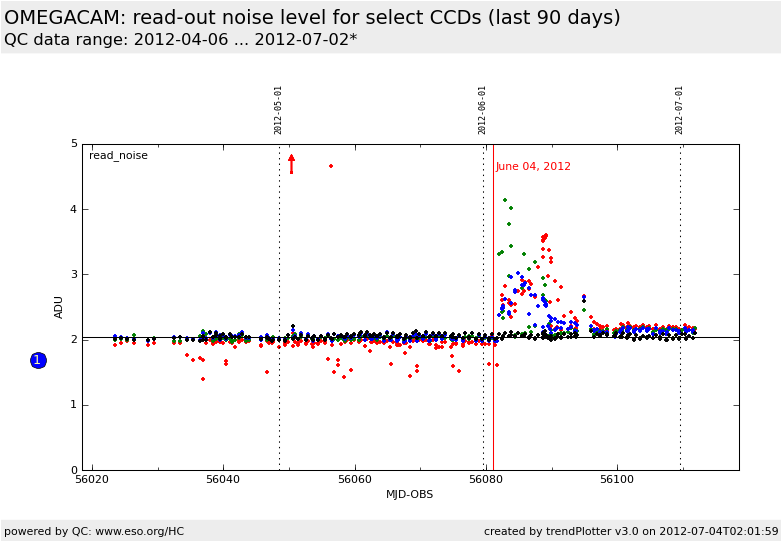 mirror sites:
PL (internal link)
HQ
[?]
mirror sites:
PL (internal link)
HQ
[?]
Quality Control and
Data Processing
|
OMEGACAM: Read-out noise
BIAS read-out noise frames are taken on a daily basis during normal VST/OmegaCAM operations. They are usually obtained during day-time calibration and consist of two, zero second, closed shutter, raw bias exposures. The rms scatter of the difference frame of these two bias exposures (divided by sqrt(2)) is the read noise in ADU. The pipeline creates one output frame from its bias-readnoise recipe (omega_readnoise): a fits table containing the read-noise values for each extension (OC_PRNA_<DATE>_1_1_normal_normal.fits).  Read-out noise
Read-out noise
The bias read-out noise averaged over all 32 detectors (in ADU) is plotted in box 1 and of individual CCDs in box2 of the trending plot. Box 3 shows scores for each CCD. Scoring&thresholds Read-out noise
The averaged read-out noise and read-out noise rms values are tightly scored, with static thresholds following the median average of the current period. The requirement is stability on the calibration timescale.
The read-out noise is determined from a pair of zero-second bias exposures. The rms scatter of the difference frame of these two bias exposures (divided by sqrt(2)) is the read noise in ADU.
2012-06-04: Following the replacement of a video board in order to address striping present in detector ESO_CCD_82, the three detectors surrounding this CCD (namely, 81 and 83) displayed strongly varying read-noise levels. After about two weeks this behaviour settled down by itself. This is evident in the health check plot monitoring the read-out noise of these three detectors (red, blue and green points) and the unaffected detector (75, black points) shown below.
|
||||||||||||||||||||||||||||||||||||||||||||||||||||||||||||||||||||||||||||||||||||||||||||||||||||||||||||||||||||||||||||||||||||||||||||||||||||||||||||||||||||||||||||||||||||||||||||||||||||||||||||||||||||||||||||||||||||||||||||||||||||||||||||||||||||||||||||||||||||||||||||||||
| |
|||||||||||||||||||||||||||||||||||||||||||||||||||||||||||||||||||||||||||||||||||||||||||||||||||||||||||||||||||||||||||||||||||||||||||||||||||||||||||||||||||||||||||||||||||||||||||||||||||||||||||||||||||||||||||||||||||||||||||||||||||||||||||||||||||||||||||||||||||||||||||||||||
 |
|
||||||||||||||||||||||||||||||||||||||||||||||||||||||||||||||||||||||||||||||||||||||||||||||||||||||||||||||||||||||||||||||||||||||||||||||||||||||||||||||||||||||||||||||||||||||||||||||||||||||||||||||||||||||||||||||||||||||||||||||||||||||||||||||||||||||||||||||||||||||||||||||||
